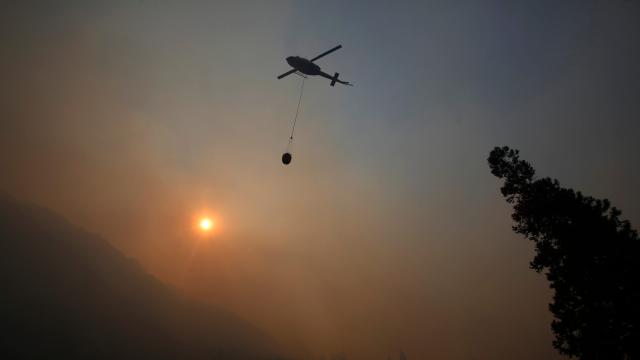As out-of-control bushfires raged across the US West, US firefighting authorities took a seemingly unusual step late last month: They called up Australia and New Zealand and asked for help.
It was the first time the southern hemisphere nations had been called on to fight US bushfires since the US summer of 2015, when 68 firefighters from Australia and New Zealand spent a month helping stamp out blazes in the Pacific Northwest.
But this nearly 20-year-old partnership has proven its value time and again over the years, with Australian and New Zealand firefighters heading north during their off-season and vice-versa. Unfortunately, climate change could make the fiery alliance harder to maintain in the future.
The US certainly needed the extra hands on deck this season. About six million acres have burned across the US West this year, already a million acres more than the 10-year average. California in particular has been on a seemingly endless tear of destructive, record setting blazes, from the Carr Fire that ripped through Redding in July to the Mendocino Complex, which spawned the biggest single fire in California’s history earlier this month.
Mike Ferris, an emergency management specialist with the US Forest Service, told us that when the nation hit a National Preparedness Level 5 with respect to fire activity (this happened just after a fire tornado exploded into life near Redding on July 26), international partners were mobilised.
This scale, which ranges from one to five, essentially describes how much of the nation’s state and federal firefighting resources are being used. Level five means personnel and other resources are basically stretched to the max, according to the National Interagency Fire Center.
“When we hit that mark, that means we’re pretty much spread thin, we’ve exceeded the ability to fill [firefighting] orders that are coming in,” Ferris said.
In early August, 140 firefighters from Australia and New Zealand arrived at the National Interagency Fire Center headquarters in Boise, Idaho, after which they were dispatched to help fight the Carr and Mendocino Complex fires in Northern California, as well as several bushfires in Oregon and Washington.
According to Ferris, the foreign firefighters could stay through the end of the month or even longer, depending on need. And with the fire situation out West still looking pretty grim, the need could definitely be there.
Ferris said that the similarity in command structure, technology, and the types of fires experienced in the hot, dry US West and the Australian bush make it easy for Australian firefighters to integrate into US brigades. The same is true when Australia calls on US firefighters.
Paradoxically, the partnership also works well because of the distance: Being in opposite hemispheres means Australia and the US experience their worst bushfires at opposite times of the year.
But as a warmer climate prolongs fire season on both sides of the equator, Lynne Tolmachoff, chief of public education at CAL-FIRE, told us resource sharing “is becoming more and more of a struggle”.
A 2016 analysis by Climate Central found that fire season in the US West is already more than 100 days longer than it was in 1970, “approaching the point where the notion of a fire season will be made obsolete by the reality of year-round wildfires”.
Australia faces a similar reality. Despite it currently being austral winter, bushfires have been flaring up by the dozens in New South Wales and Queensland, fuelled by prolonged drought and mild temperatures that have turned the region into a tinderbox.
In New South Wales, 14 local council areas have already declare bushfire season open, something that normally wouldn’t happen until October, according to Lesley Hughes, an ecologist with the Australian Climate Council.
She sees this as an ominous sign, one that’s in line with the findings of a recent Climate Council report (of which Hughes is a member) showing that bushfire season is intensifying in the southwest and southeast, placing additional pressure on firefighting personnel and aircraft that are shared with other countries.
“At the very time where we have sent personnel to the US to help with your fires over there, we actually need them over here,” she told us. “That’s one of the problems with the climate changing — we see extension both at the beginning and end of the fire season as well as the severity ramping up.”
David Bowman, a fire ecologist at the University of Tasmania, agreed that the sharing of wildfire resources would become harder as the climate becomes warmer and drier.
“Our fire seasons have merged,” he told us. “This summer has just been a watershed moment.”
He thinks we need accept the fact that the fiery future is upon us and start proactively addressing that through adaptation, whether that means more prescribed fires, stricter building codes, or managed retreat from the wildland-urban interface.
Until we’ve figured out how to manage our new pyrotechnic reality, firefighters will find it harder to catch a break as they’re increasingly being flown across the world to battle blazes all year long.
